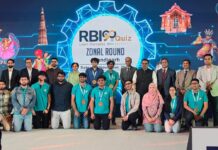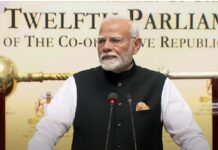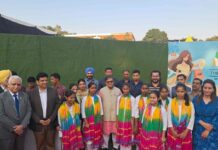SUNEHRA PUNJAB PARTY LAUNCHED
Announces agenda for reform, regeneration and growth
Chandigarh, January 31, 2022: Sanjha Sunehra Punjab Manch which was established in August last year under the leadership of Mr. K.C. Singh, IFS (retd.) today announced political party Sunehra Punjab Party at a launch press conference at Hyatt Regency here today.
Former Ambassador K C Singh (Krishan Chander Singh), Indian Foreign Service (Retd),
was Envoy to the United Arab Emirates (UAE), and Iran. He then was Additional Secretary (International Organisations) & Coordinator Counter Terrorism inthe Ministry of External Affairs, finally rising to the post of Secretary, Economic Relations.
Mr. K.C. Singh, National President of the Party, while speaking at the launch event said, “A small but diverse group of individuals – civil, military, sports and civil society came together to establish the Sanjha Sunehra Punjab Manch at end August, 2021. After five months of holding interactive public meetings the common refrain heard was that change was not possible unless good Punjabis stepped forward to occupy the political space getting vacated.
“Consequently, most Manch members endorsed the decision to register a political party with the Election Commission of India. The Election Commission has approved the proposed name, Sunehra Punjab Party,” he added.
Mr. Singh, said, to enable the people of Punjab to make the right electoral choice following is the Party’s agenda for change and growth:
- To overcome rampant corruption there is need for comprehensive administrative, including police, reform and systemic changes. In particular, a commission should be established to review the entire bureaucratic structure and maze of rules and regulations. Police, excise, revenue department in particular need total overhaul.
- To put Punjab back on high growth path the three segments i.e., agriculture, manufacturing and services need separate and focussed attention. Punjab’s Gross State Domestic Product (GSDP) has following: Agriculture 27 %, manufacturing 24%, services 49%. The last two need to increase their share.
iii. Agriculture: Any model of growth for 21st Century Punjab has to be ecologically safe and sustainable. The present wheat – rice crop cycle, dependant on high fertiliser pesticide and water use is not sustainable. Crop diversification, including sowing oil seeds and lentils, fruits and vegetables etc. is overdue. To wean the farmers off their existing dependence on Green Revolution era grain growing, needs a Second Green Revolution. This requires a 10-20 year plan which is not achievable without external funding, MSP extended to new crops, State assured supply chains and new markets in India and overseas. Global Warming will impact crop growing as now practiced. R&D is needed by agricultural universities and research institutions to genetically modify seeds for new conditions. Punjab would need massive national and international funding for transition from the existing agricultural scheme to a 21st Century model.
- Manufacturing: Punjab never fully recovered from the setback delivered to manufacturing, first by militancy in the 1980s and then the collapse of Soviet Union in 1991 which crippled the Ludhiana knitwear industry. The 21st Century Industrial model has to be akin to the Californian mix of high technology, agriculture-cum horticulture and clean industry. Air and water pollution and soil degradation must be checked. As a land locked state in the north-west corner of India, heavy industry is inappropriate. Talk of inviting automobile manufacturers like Tesla is illogical as car manufacturers would prefer being on the coast. Punjab model has to be built around higher institutions f excellence. Without Stanford University there would be no Silicon Valley in California. SAS Nagar had a semi-conductor complex established in the 1970s. But Punjab has failed to turn the area into a chip – making hub, of which there is a global shortage.
- Services: In the services segment Punjab has failed to draw tourist because of neglecting historical buildings like forts from Maharaja Ranjit Singh period or even spots like where Emperor Akbar was crowned. Despite excellent highways, transportation and hotels have become political bacon in hands of politicians. Religious tourism needs better coordination. Encouraging villages with forts or heritage homes to welcome tourist.
- Education: To draw investment into Punjab the youth need quality education and good health. Upgraded government schools need a Punjab model of curriculum, trained teachers and well-equipped schools. Remote teaching via net-based lessons can diminish the gap in quality of teaching in a rural or urban school.
vii. Health: Upgrade of medical facilities is an urgent need. Patients rushing to referral hospitals with conditions which should be treatable at normal district hospital creates a logjam at the upper level. Despite Union Government’s scheme to upgrade health sub centres as Health Wellness Centres and Punjab Government claims it has operationalized 2820 such centres, the availability of basic medical care near the village is still erratic. At the core of this lies the problem of shortages of doctors and medical experts. A complete rejig of the entire health system with resources raise locally and abroad.
Mr. Singh said, “In keeping with Guru Nanak’s teachings, empowering women to be fully participative members of Punjab’s social, political and economic growth is a priority with Sunehra Punjab. We aim to give women their due through basic education and skill training resources, safety, health facilities, gender parity and equality in professional growth.”
“The challenges are so severe and Punjab’s ecosystem so pronounced that to put it back on the path to a ‘Golden Era’ would need leaders who have expertise at a national and international level, and the ability to attract talent and use it. Punjab can be rescued. But only if a comprehensive vision is laid down and path towards it laid,” Mr. K.C. Singh concluded.
















